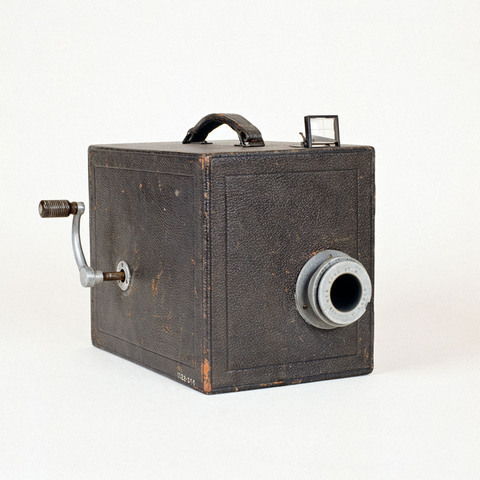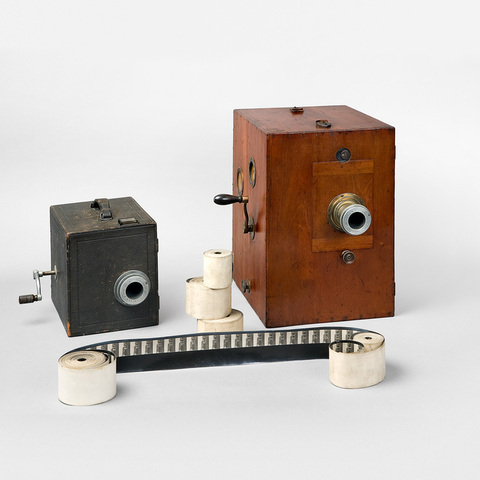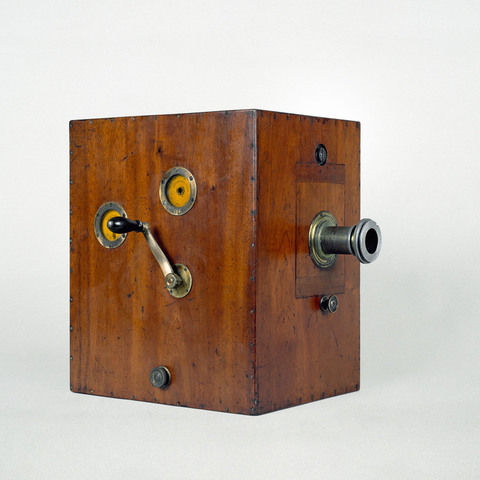Caméra film 24 mm
Fiche détaillée
Type de l'appareil
boîte en bois gainée de cuir ; film 24 mm non perforé sur papier sensible ou celluloïd (40 pieds) ; entraînement par rotation de la bobine réceptrice et par friction grâce à un rouleau en partie évidé (genre Bouly) ; viseur ; compteur de pellicule ; manivelle ; mécanisme se déplaçant pour passer du viseur à la prise de vues ; poignée ; deux magasins récepteurs et débiteurs
Auteurs
Chipperfield Walter
Romford, Snydale Hall, near Pontefract
Garforth William Edward
Romford, Snydale Hall, near Pontefract
Fabricants
Bond's Limited
Londres, 138 New Bond Street
Utilisateurs
Chipperfield Walter
Romford, Snydale Hall, near Pontefract
Garforth William Edward
Romford, Snydale Hall, near Pontefract
Distributeurs
Bond's Limited
Londres, 138 New Bond Street
Sujet du modèle
Informations non disponibles
Objectif
Beck Neostigmar F. 3.5, 3 inch, n° 150 087
Taille de l'objet
Ouvert :
Informations non disponibles
Fermé :
Longueur : 26 cm
Largeur : 23.5 cm
Hauteur : 22.5 cm
Diamètre :
Informations non disponibles
Taille de la boîte de transport
Informations non disponibles
Remarques
Voir modèle pour professionnel : AP-95- 1399. Peut prendre environ 640 images.
"The Kinora Camera is an appearance very much like an ordinary reflex camera, except that is has a crank handle at one side. It is splendidly made, covered with morocco leather, and, as all possible metal parts are made of aluminium [...], it is small enough and light enough to be carried easily in one hand. The lens is a specially designed Isostigmar, by Beck, of wonderful definition and rapidity, working at F. 3.5, and is carried in a lens tube which moves freely for focussing. [...] Instead of the expensive celluloid films, the Kinora Camera takes a specially designed reel of paper negative, carrying 640 individual pictures, and it is the first living-picture camera in which paper negatives have been successfully used. They are sensitised with the fastest emulsion in the world and have considerable ortho-chromatic quality. [...] A spool of film, as received from Bond's Ltd., is opened in darkness or by a ruby light (a candle lamp for the purpose can be bought anywhere for a shilling or less) and placed in the light-tight spool-box. This can then be carried in the daylight to the camera and slipped into its place. The Kinora Camera is then ready to work. [...] For well-lighted interiors or dull cloudy weather out of doors, the lens is used at its full aperture ; for out-door photographs, where there are bright clouds but no sun, the lens is stopped to F. 5.6 ; in bright sunshine, or for bright seascapes, the lens is stopped to F. 8. As soon as the picture is in focus, the handle is pushed back and locked firmly in position. To operate the Kinora Camera, all that is now required is to turn the handle at a moderate and reasonably regular speed at about two revolutions a second. The turning of the handle causes a revolving shutter to expose successive portions of the negative paper. [...] A pointer at the back of the Camera indicates how much of the negative has been used at any moment. As the spool is exposed it is wound into a second spool-box in the camera. [...] The box is then posted to Bond's Ltd., where the film is developed and printed. The cost is very trifling - the complete paper-film costs 1/6 to buy and 1/- to develop, and it can be printed and mounted on the Kinora Reel, ready to view in the Kinora, for 3/6. Let the Amateur compare this with the ordinary cinematograph apparatus, which involves an outlay of from £ 50 to £ 100 in the first place, £ 3 to produce the picture reels whether successful or not, and long practice before success is achieved. [...] Kinora camera, cash price, £ 19.0.0. ; Kinora camera with Zeiss Tessar F. 3.5 3 in., £ 25.0.0. ; 40 ft. paper film, £ 0.1.6. ; 40 ft celluloid film, £ 0.5.0." (The British Journal Almanac Advertisements, Motion Photography for Amateurs, London, Bond's Ltd., s.d.).
Bibliographie
The British Journal Almanac Adverstisements, Motion Photography for Amateurs, London, Bond's Ltd., s.d.
Barry Anthony, The Kinora, Motion pictures for the home 1896-1914, London, The Projection Box, 1996.
The Kinora Library, A Descriptive Lost of Moving Pictures that you may see in your own home, a reprint of the catalogue of Kinora reels published by Bond's Ltd, London, c. 1911, Hastings, East Sussex, The Projection Box, 2001.


